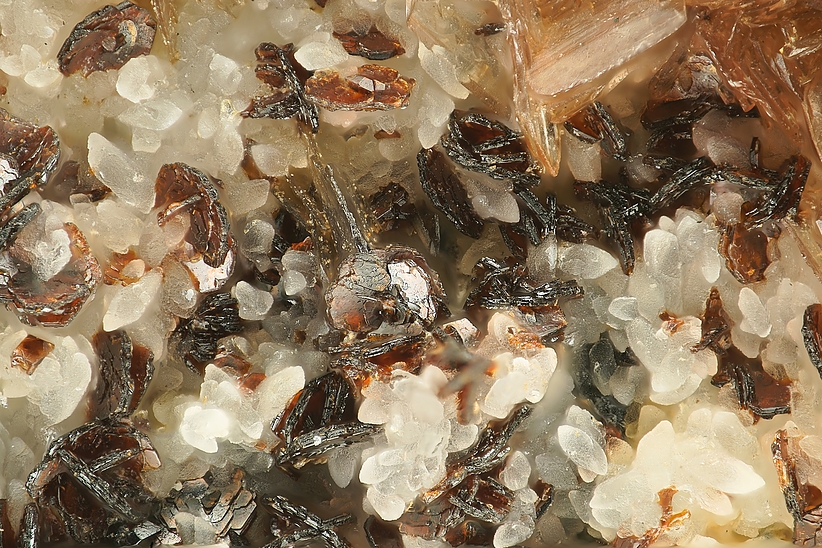Hematolite
A valid IMA mineral species - grandfathered
This page is currently not sponsored. Click here to sponsor this page.
About Hematolite
Formula:
(Mn,Mg,Al,Fe3+)15(As5+O4)2(As3+O3)(OH)23
Cation requirements for charge balance suggest that there about two 3+ cations per formula unit. The original 3+ cations determined by Moore and Araki (1978) were Al-dominant. Polytypic stacking may be present resulting in formula variations.
Colour:
Brown-red, blood-red, nearly black; reddish orange to yellowish brown in transmitted light.
Lustre:
Vitreous, Sub-Vitreous, Resinous, Pearly, Sub-Metallic
Hardness:
3½
Specific Gravity:
3.49
Crystal System:
Trigonal
Member of:
Name:
Named as aimatolit (Swedish) in 1884 by Lars Johan Igelstrom from the Greek αίμα for "blood" and λίθος for "stone", in allusion to its red pyrope-like colour.
Dark blood-red platy crystals (< 1 mm) and crusts.
Unique Identifiers
Mindat ID:
1857
Long-form identifier:
mindat:1:1:1857:5
GUID
(UUID V4):
(UUID V4):
8b74320d-24c9-422a-97aa-cd4e93e1a9cf
IMA Classification of Hematolite
Approved, 'Grandfathered' (first described prior to 1959)
IMA Formula:
(Mn,Mg,Al)15(AsO4)2(AsO3)(OH)23
Classification of Hematolite
8.BE.45
8 : PHOSPHATES, ARSENATES, VANADATES
B : Phosphates, etc., with additional anions, without H2O
E : With only medium-sized cations, (OH, etc.):RO4 > 2:1
8 : PHOSPHATES, ARSENATES, VANADATES
B : Phosphates, etc., with additional anions, without H2O
E : With only medium-sized cations, (OH, etc.):RO4 > 2:1
43.4.6.1
43 : COMPOUND PHOSPHATES, ETC.
4 : Anhydrous Compound Phosphates, etc·, Containing Hydroxyl or Halogen
43 : COMPOUND PHOSPHATES, ETC.
4 : Anhydrous Compound Phosphates, etc·, Containing Hydroxyl or Halogen
20.8.21
20 : Arsenates (also arsenates with phosphate, but without other anions)
8 : Arsenates of Mn
20 : Arsenates (also arsenates with phosphate, but without other anions)
8 : Arsenates of Mn
Mineral Symbols
As of 2021 there are now IMA–CNMNC approved mineral symbols (abbreviations) for each mineral species, useful for tables and diagrams.
| Symbol | Source | Reference |
|---|---|---|
| Hmt | IMA–CNMNC | Warr, L.N. (2021). IMA–CNMNC approved mineral symbols. Mineralogical Magazine, 85(3), 291-320. doi:10.1180/mgm.2021.43 |
Physical Properties of Hematolite
Vitreous, Sub-Vitreous, Resinous, Pearly, Sub-Metallic
Transparency:
Translucent
Comment:
Pearly to sub-metallic on cleavage surfaces.
Colour:
Brown-red, blood-red, nearly black; reddish orange to yellowish brown in transmitted light.
Streak:
Light chocolate-brown to reddish brown
Hardness:
3½ on Mohs scale
Tenacity:
Brittle
Cleavage:
Perfect
On {0001}, perfect
On {0001}, perfect
Fracture:
Irregular/Uneven
Density:
3.49 g/cm3 (Measured) 3.48 g/cm3 (Calculated)
Optical Data of Hematolite
Type:
Uniaxial (-)
RI values:
nω = 1.733 nε = 1.714
Birefringence:
0.019
Max Birefringence:
δ = 0.019

Image shows birefringence interference colour range (at 30µm thickness)
and does not take into account mineral colouration.
and does not take into account mineral colouration.
Surface Relief:
High
Pleochroism:
Non-pleochroic
Comments:
The crystals are divided into differently oriented, anomalously biaxial sectors at times.
Chemistry of Hematolite
Mindat Formula:
(Mn,Mg,Al,Fe3+)15(As5+O4)2(As3+O3)(OH)23
Cation requirements for charge balance suggest that there about two 3+ cations per formula unit. The original 3+ cations determined by Moore and Araki (1978) were Al-dominant. Polytypic stacking may be present resulting in formula variations.
Cation requirements for charge balance suggest that there about two 3+ cations per formula unit. The original 3+ cations determined by Moore and Araki (1978) were Al-dominant. Polytypic stacking may be present resulting in formula variations.
Crystallography of Hematolite
Crystal System:
Trigonal
Class (H-M):
3 - Rhombohedral
Space Group:
R3
Cell Parameters:
a = 8.275 Å, c = 36.60 Å
Ratio:
a:c = 1 : 4.423
Unit Cell V:
2,170.44 ų (Calculated from Unit Cell)
Z:
3
Morphology:
Crystals thick tabular {0001} with large {0115}, or rhombohedral with {0115} alone. The rhombohedral faces are striated horizontally.
Comment:
Basic repeat distance of 12.2 A of a five-layer structure found
Crystal Structure
Load
Unit Cell | Unit Cell Packed
2x2x2 | 3x3x3 | 4x4x4
Unit Cell | Unit Cell Packed
2x2x2 | 3x3x3 | 4x4x4
Show
Big Balls | Small Balls | Just Balls | Spacefill
Polyhedra Off | Si Polyhedra | All Polyhedra
Remove metal-metal sticks
Big Balls | Small Balls | Just Balls | Spacefill
Polyhedra Off | Si Polyhedra | All Polyhedra
Remove metal-metal sticks
Display Options
Black Background | White Background
Perspective On | Perspective Off
2D | Stereo | Red-Blue | Red-Cyan
Black Background | White Background
Perspective On | Perspective Off
2D | Stereo | Red-Blue | Red-Cyan
View
CIF File Best | x | y | z | a | b | c
CIF File Best | x | y | z | a | b | c
Rotation
Stop | Start
Stop | Start
Labels
Console Off | On | Grey | Yellow
Console Off | On | Grey | Yellow
Data courtesy of the American Mineralogist Crystal Structure Database. Click on an AMCSD ID to view structure
| ID | Species | Reference | Link | Year | Locality | Pressure (GPa) | Temp (K) |
|---|---|---|---|---|---|---|---|
| 0000610 | Hematolite | Moore P B, Araki T (1978) Hematolite: A complex dense-packed sheet structure American Mineralogist 63 150-159 |  | 1978 | 0 | 293 |
CIF Raw Data - click here to close
X-Ray Powder Diffraction
Powder Diffraction Data:
| d-spacing | Intensity |
|---|---|
| 6.12 Å | (80) |
| 5.63 Å | (30) |
| 5.20 Å | (50) |
| 4.14 Å | (80) |
| 3.40 Å | (40) |
| 4.22 Å | (40) |
| 2.60 Å | (40) |
| 2.39 Å | (100) |
| 1.562 Å | (90) |
Comments:
Berry and Graham (1948)
Geological Environment
Paragenetic Mode(s):
| Paragenetic Mode | Earliest Age (Ga) |
|---|---|
| High-𝑇 alteration and/or metamorphism | |
| 32 : Ba/Mn/Pb/Zn deposits, including metamorphic deposits | |
| 33 : Minerals deposited by hydrothermal metal-rich fluids (see also [#12]) |
Geological Setting:
Unnamed, possible ferric analog of hematolite occurs at Ogdensburg, New Jersey (Dunn and Peacor, 1983). The mineral occurs in fractures of red willemite-franklinite-calcite ore as well as on friedelite-magnetite rock.
Type Occurrence of Hematolite
Geological Setting of Type Material:
Veinlets or cavities in crystalline limestone of a stratabound Mn-Fe ore deposit.
Associated Minerals at Type Locality:
Synonyms of Hematolite
Other Language Names for Hematolite
Relationship of Hematolite to other Species
Member of:
Other Members of this group:
| Arakiite | (Zn,Mn2+)(Mn2+,Mg)12(Fe3+,Al)2(As5+O4)2(As3+O3)(OH)23 | Mon. m : Bb |
| Dixenite | CuMn2+14Fe2+(SiO4)2(As5+O4)(As3+O3)5(OH)6 | Trig. 3 : R3 |
| Kraisslite | Zn3(Mn,Mg)25(Fe3+,Al)(As3+O3)2[(Si,As5+)O4]10(OH)16 | Orth. 2 2 2 : C2 2 21 |
| Mcgovernite | Mn19Zn3(AsO4)3(AsO3)(SiO4)3(OH)21 | Trig. 3m (3 2/m) |
| Synadelphite | Mn2+9(As5+O4)2(As3+O3)(OH)9 · 2H2O | Orth. mmm (2/m 2/m 2/m) : Pnma |
| Turtmannite | (Mn,Mg)22.5Mg3-3x((V5+,As5+)O4)3(As3+O3)x(SiO4)3O5-5x(OH)20+x | Trig. |
Common Associates
Associated Minerals Based on Photo Data:
| 5 photos of Hematolite associated with Allactite | Mn2+7(AsO4)2(OH)8 |
| 4 photos of Hematolite associated with Synadelphite | Mn2+9(As5+O4)2(As3+O3)(OH)9 · 2H2O |
| 4 photos of Hematolite associated with Calcite | CaCO3 |
| 4 photos of Hematolite associated with Magnetite | Fe2+Fe3+2O4 |
| 4 photos of Hematolite associated with Pyrochroite | Mn(OH)2 |
| 3 photos of Hematolite associated with Dolomite | CaMg(CO3)2 |
| 1 photo of Hematolite associated with Jacobsite | Mn2+Fe3+2O4 |
| 1 photo of Hematolite associated with Akrochordite | (Mn2+,Mg)5(AsO4)2(OH)4 · 4H2O |
| 1 photo of Hematolite associated with Baryte | BaSO4 |
Related Minerals - Strunz-mindat Grouping
| 8.BE.05 | Augelite | Al2(PO4)(OH)3 |
| 8.BE.10 | Grattarolaite | Fe3+3(PO4)O3 |
| 8.BE.15 | Cornetite | Cu3(PO4)(OH)3 |
| 8.BE.20 | Clinoclase | Cu3(AsO4)(OH)3 |
| 8.BE.25 | Arhbarite | Cu2Mg(AsO4)(OH)3 |
| 8.BE.25 | Gilmarite | Cu3(AsO4)(OH)3 |
| 8.BE.30 | Allactite | Mn2+7(AsO4)2(OH)8 |
| 8.BE.30 | Flinkite | Mn2+2Mn3+(AsO4)(OH)4 |
| 8.BE.30 | Raadeite | Mg7(PO4)2(OH)8 |
| 8.BE.30 | Argandite | Mn7(VO4)2(OH)8 |
| 8.BE.35 | Chlorophoenicite | (Mn,Mg)3Zn2(AsO4)(OH,O)6 |
| 8.BE.35 | Magnesiochlorophoenicite | (Mg,Mn)3Zn2(AsO4)(OH,O)6 |
| 8.BE.35 | Mineral E (of Dunn, et. al., 1982) | |
| 8.BE.40 | Gerdtremmelite | (Zn,Fe)(Al,Fe)2(AsO4)(OH)5 |
| 8.BE.45 | Dixenite | CuMn2+14Fe2+(SiO4)2(As5+O4)(As3+O3)5(OH)6 |
| 8.BE.45 | Kraisslite | Zn3(Mn,Mg)25(Fe3+,Al)(As3+O3)2[(Si,As5+)O4]10(OH)16 |
| 8.BE.45 | Mcgovernite | Mn19Zn3(AsO4)3(AsO3)(SiO4)3(OH)21 |
| 8.BE.45 | Arakiite | (Zn,Mn2+)(Mn2+,Mg)12(Fe3+,Al)2(As5+O4)2(As3+O3)(OH)23 |
| 8.BE.45 | Turtmannite | (Mn,Mg)22.5Mg3-3x((V5+,As5+)O4)3(As3+O3)x(SiO4)3O5-5x(OH)20+x |
| 8.BE.45 | Carlfrancisite | Mn2+3(Mn2+,Mg,Fe3+,Al)42[As3+O3]2(As5+O4)4[(Si,As5+)O4]6[(As5+,Si)O4]2(OH)42 |
| 8.BE.50 | Synadelphite | Mn2+9(As5+O4)2(As3+O3)(OH)9 · 2H2O |
| 8.BE.55 | Holdenite | (Mn2+,Mg)6Zn3(AsO4)2(SiO4)(OH)8 |
| 8.BE.60 | Kolicite | Mn2+7Zn4(AsO4)2(SiO4)2(OH)8 |
| 8.BE.65 | Sabelliite | (Cu,Zn)2Zn(AsO4,SbO4)(OH)3 |
| 8.BE.70 | Jarosewichite | Mn2+3Mn3+(AsO4)(OH)6 |
| 8.BE.75 | Theisite | Cu5Zn5(AsO4,SbO4)2(OH)14 |
| 8.BE.80 | Coparsite | Cu4(AsO4,VO4)O2Cl |
| 8.BE.85 | Waterhouseite | Mn2+7(PO4)2(OH)8 |
| 8.BE.90 | Vasilseverginite | Cu9O4(AsO4)2(SO4)2 |
Fluorescence of Hematolite
Not fluorescent in UV
Other Information
Notes:
Readily soluble in acids.
Alters to Manganite.
Alters to Manganite.
Health Risks:
No information on health risks for this material has been entered into the database. You should always treat mineral specimens with care.
Internet Links for Hematolite
mindat.org URL:
https://www.mindat.org/min-1857.html
Please feel free to link to this page.
Please feel free to link to this page.
Search Engines:
External Links:
Mineral Dealers:
References for Hematolite
Reference List:
Igelström, Lars Johan (1884) Manganostibiit, Aimatolit och Aimafibrit, tre nya mineral från Mossgrufvan i Nordmarken. Geologiska Föreningen i Stockholm Förhandlingar, 7 (4) 210-212 doi:10.1080/11035898409443535
Larsen, Esper S. (1921) The microscopic determination of the nonopaque minerals. Bulletin Vol. 679. US Geological Survey doi:10.3133/b679 p.83
Berry, L. G., Graham, A. R. (1948) X-ray measurements on brackebuschite and hematolite. American Mineralogist, 33 (7-8) 489-495
Moore, Paul B., Araki, Takaharu (1978) Hematolite: a complex dense-packed sheet structure. American Mineralogist, 63 (1-2) 150-159
Localities for Hematolite
Locality List
 - This locality has map coordinates listed.
- This locality has map coordinates listed.
 - This locality has estimated coordinates.
ⓘ - Click for references and further information on this occurrence.
? - Indicates mineral may be doubtful at this locality.
- This locality has estimated coordinates.
ⓘ - Click for references and further information on this occurrence.
? - Indicates mineral may be doubtful at this locality.
 - Good crystals or important locality for species.
- Good crystals or important locality for species.
 - World class for species or very significant.
(TL) - Type Locality for a valid mineral species.
(FRL) - First Recorded Locality for everything else (eg varieties).
- World class for species or very significant.
(TL) - Type Locality for a valid mineral species.
(FRL) - First Recorded Locality for everything else (eg varieties).
All localities listed without proper references should be considered as questionable.
Sweden | |
| Holtstam et al. (1999) |
| Natural History Museum | |
| Österberg (2003) | |
| Gatedal (n.d.) +1 other reference | |
| Moore (1978) | |
| Nysten (1987) | |
| Igelström (1884) +3 other references | |
| Nysten (2004) |
Quick NavTopAbout HematoliteUnique IdentifiersIMA Classification Classification Mineral SymbolsPhysical Properties Optical Data Chemistry Crystallography Crystal StructureX-Ray Powder DiffractionGeological EnvironmentType Occurrence SynonymsOther LanguagesRelationshipsCommon AssociatesStrunz-MindatFluorescence Other InformationInternet Links References Localities Locality List





 symbol to view information about a locality.
The
symbol to view information about a locality.
The 



Moss mine, Nordmark Odal Field, Filipstad, Värmland County, Sweden